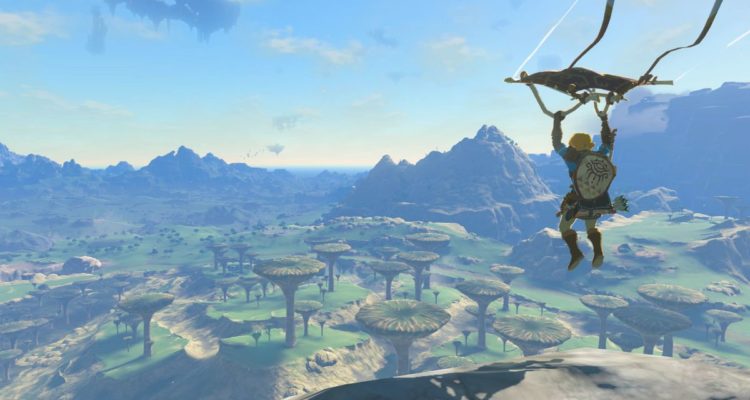In the vast landscape of video games, only a handful manage to transcend time and leave an indelible mark on the gaming community. It’s no secret that The Legend of Zelda series is a mainstay in this group, consistently delivering masterpiece after masterpiece after relatively underwhelming game after masterpiece (hey, some not-so-masterpiece ones slip in there from time to time). The latest addition to this illustrious lineage, however, is no slip by any means.
The Legend of Zelda: Tears of the Kingdom upholds the legendary legacy any raises the bar for what a gaming experience should be. This journey is a breathtaking amalgamation of stunning visuals, enchanting audio, innovative gameplay mechanics, and a storyline that plucks at emotional and comedic strings alike.
Tears of the Kingdom is the same visual feast as its predecessor, Breath of the Wild, a testament to the technical prowess that can be squeezed from the Nintendo Switch, despite the general consensus that the hardware is underpowered (it’s still time for a much beefier Switch 2, though). Hyrule has never looked more captivating, diverse landscapes seamlessly transitioning from fields to mountains, familiar locales and entirely new ones. The world feels even more alive with detail than before, despite being significantly darker in theme.
Character animation is fluid, and characters’ faces are remarkably expressive, conveying a range of emotions that add a layer of depth to the storytelling. Dynamic weather and lighting effects contribute to the game’s overall realism, making every moment a visual spectacle.
The audio landscape of Tears of the Kingdom is nothing short of a symphonic masterpiece. The iconic Zelda theme, a melody etched in the minds even of those who haven’t played the series in many years, is seamlessly woven into the game’s soundtrack, providing a familiar yet fresh musical backdrop to Link’s latest adventure. Each region boasts its own distinct musical identity, further contributing to this fully harmonious world.
Sound effects in Tears of the Kingdom are also meticulous in their function. From the clash of weapons in intense combat to the rustling of leaves as Link explores the vast landscapes, each sound serves to immerse players further into the game. These small details are littered throughout the game and are awe-inspiring considering the game’s scale. The strategic use of ambient sounds adds an extra layer of authenticity to every moment. While background music can often become repetitive in certain areas, this is the tiniest of quibbles in an otherwise stellar audio experience.
At its core, Tears of the Kingdom adheres to the re-written Zelda formula introduced in Breath of the Wild. However, new runes and the goopy connect-anything-to-anything-to-make-new-things called Ultrahand is absolutely the standout addition. There are quite literally endless ways to tackle challenges, shrines, and quests, and somehow the game doesn’t become overly simplified or exceptionally easy just because there is probably a way to build a machine to accomplish a task more quickly.
Familiar tools such as the paraglider return, making possible the go-anywhere, climb-anything mechanics made popular in Breath of the Wild. The impressive absence of invisible barriers (save for the extreme edges of the map) encourages players to literally do just that.
Dungeons, a hallmark of the Zelda franchise, were notably absent from Breath of the Wild, and have sort of made a return in Tears of the Kingdom. Indeed, the more traditional dungeons of the franchise have not yet returned, but the ones we do have are much more unique in layout and gameplay, not to mention design and overall differentiation amongst each other as well.
The Legend of Zelda series has always excelled in delivering captivating narratives, and Tears of the Kingdom continues this tradition with a story that is both emotionally resonant and epic in scope. Without delving into spoilers, the game weaves another tale of courage, wisdom, and power, picking up where its predecessor left off, and providing a compelling reason for why Link is indeed back to just three hearts after amassing all of them in his previous adventure.
The narrative continues to unfold organically through gameplay, and the player truly directs this. We started off by heading northeast, despite the game imploring us to go west. We also hit the endgame accidentally (yes, actually), and there was a modified story event that took place to account for the people we hadn’t met and the missions we hadn’t yet accomplished. Truly, Nintendo has weaved a seamless fusion of storytelling and player agency. The freedom to approach objectives in any order adds replayability, and the consequence of player choices shapes the unfolding story. The narrative pacing is expertly handled, with moments of quiet reflection pressed against high-stakes action.
Character development is another strong suit, with both Link and Zelda evolving in meaningful ways throughout the journey. The supporting cast is equally well-written, zany, and weird in their own Zelda-like way, with each character contributing to the overarching narrative.
The narrative is complemented by rich lore and extensive world-building, rewarding players who take the time to explore every nook and cranny of Hyrule. The result is a narrative that not only stands on its own but adds layers of depth to the already compelling Zelda universe.
The Legend of Zelda: Tears of the Kingdom is a masterclass in storytelling and gaming. With breathtaking visuals, a mesmerizing soundtrack, engaging gameplay mechanics, and a captivating storyline, it epitomizes the essence of what makes the Zelda series truly legendary.
This review is based on a copy of The Legend of Zelda: Tears of the Kingdom provided by Nintendo. Read our reviews policy here.

